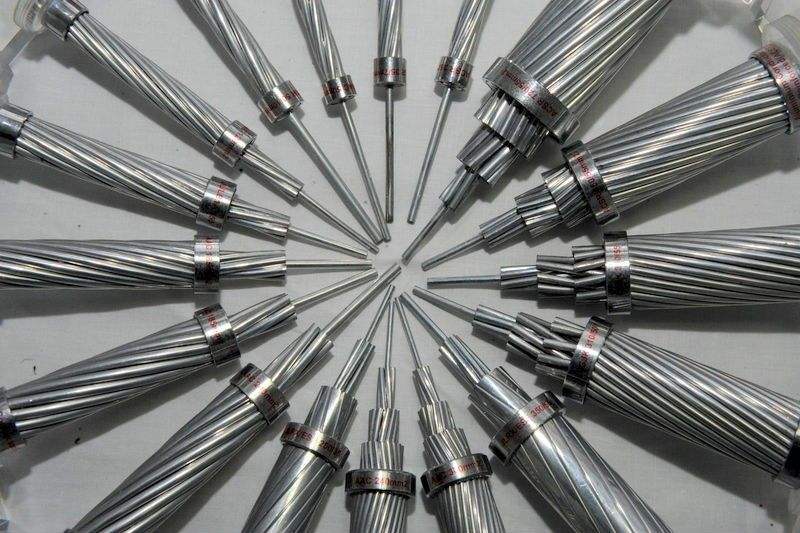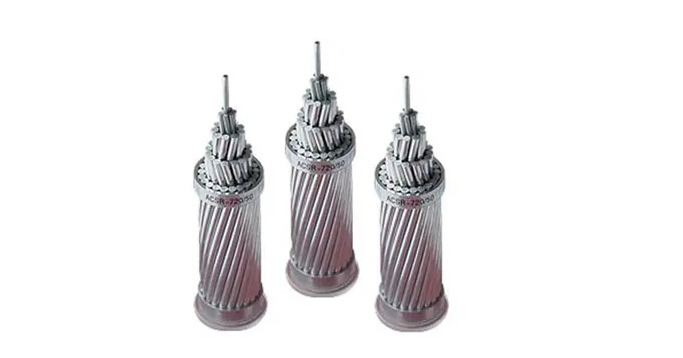ACSR conductor's full name is ALUMINUM CONDUCTORS STEEL-REINFORCED CABLE, consist of a solid or stranded steel core surrounded by strands of aluminum (E.C. GRADE), which has a simple structure, easy erection, and maintenance, low line cost, large transmission capacity, and facilitates the laying of special geographical conditions such as across rivers and valleys.
Advantages of ACSR Conductor
With good electrical conductivity, sufficient mechanical strength, and tensile strength, tower distance can be enlarged as other characteristics.
Therefore, it is widely used in overhead transmission and distribution lines of various voltage levels.
ACSR conductors are available in a wide range of steel, containing carbon from 0.5% to 0.85 %.
For high-voltage transmission lines, due to the limited path of the line, it is not possible to put more than one line on a path.
People will come up with a path, a set of towers, hanging more than one wire method, that is, a line equivalent to the erection of multiple lines.
For the 500KV transmission line, mostly uses the way of hanging four wires, this way of erecting the line is called the same tower and frame.
The higher strength ACSR conductors are used for river crossings, overhead ground wires, installations involving extra long spans, etc.
Against any given resistance of the conductor, ACSR may be manufactured within a wide range of tensile strength as per the requirement.

The essential difference between the two types of aluminum conductors is that the materials are different.
The aluminum stranded wire is AAAC, and the steel core aluminum stranded wire is ACSR, but the difference is not very big from the outside, so without professional explanation, these two cables usually easy to be confused by others.
ACSR Cable
Steel-core aluminum-stranded wire is made of aluminum and steel-stranded wire, suitable for overhead transmission lines.
AAAC Conductor
Defined as stranded wire in which all strands are aluminum alloy wire.
Regarding the types of ACSR conductors, there is no other type, only different standards, there.
The principal advantage of these conductors is their high tensile strength, so they are used for longer spans with less support.
Due to the greater diameter of ACSR conductor wire a much higher corona limit can be obtained causing significant advantages on high and extra high voltage overhead lines.

| Sr. No. | Cond. Area mm2 |
Stranding Dia in mm Alum. |
Wire Steel |
Calculated sectional Sq.mm Alum. |
Area ACSR |
Approx overall Dia mm ACSR |
Weight kg/km ACSR |
Weight kg/km Alum. |
Weight kg/km Steel |
Calc. Electrical Resistance at 20oC Ohms/km Cond. |
| 1. | 10 | 6/1.50 | 1/1.50 | 10.60 | 12.37 | 4.50 | 43 | 29 | 14 | 2.780 |
| 2. | 18 | 6/1.95 | 1/1.95 | 18.10 | 21.12 | 5.88 | 73 | 50 | 23 | 1.618 |
| 3. | 20 | 6/2.11 | 1/2.11 | 20.98 | 24.48 | 6.33 | 85 | 58 | 27 | 1.394 |
| 4. | 30 | 6/2.59 | 1/2.59 | 31.61 | 36.88 | 7.77 | 128 | 87 | 41 | 0.929 |
| 5. | 50 | 6/3.35 | 1/3.35 | 52.88 | 61.70 | 10.05 | 214 | 145 | 69 | 0.552 |
| 6. | 80 | 6/4.09 | 1/4.09 | 78.83 | 91.97 | 12.27 | 319 | 216 | 103 | 0.371 |
| 7. | 100 | 6/4.72 | 7/1.57 | 105.00 | 118.50 | 14.15 | 394 | 288 | 106 | 0.279 |
| 8. | 150 | 30/2.59 | 7/2.59 | 158.10 | 194.90 | 18.13 | 726 | 437 | 289 | 0.187 |
| 9. | 200 | 30/3.0 | 7/3.00 | 212.10 | 261.50 | 21.00 | 974 | 586 | 388 | 0.139 |
| 10. | 400 | 42/3.50 | 7/1.96 | 404.10 | 425.20 | 26.88 | 1281 | 1116 | 165 | 0.073 |
| 11. | 420 | 54/3.18 | 7/3.18 | 428.90 | 484.50 | 28.62 | 1621 | 1186 | 435 | 0.069 |
| 12. | 520 | 54/3.53 | 7/3.53 | 528.50 | 597.00 | 31.77 | 2004 | 1461 | 537 | 0.056 |
| 13. | 560 | 42/4.13 | 7/2.30 | 562.70 | 591.70 | 31.68 | 1787 | 1553 | 228 | 0.052 |
| 14. | 690 | 42/4.57 | 7/2.54 | 688.9 | 724.4 | 35.04 | 2187 | 1901 | 285 | 0.042 |